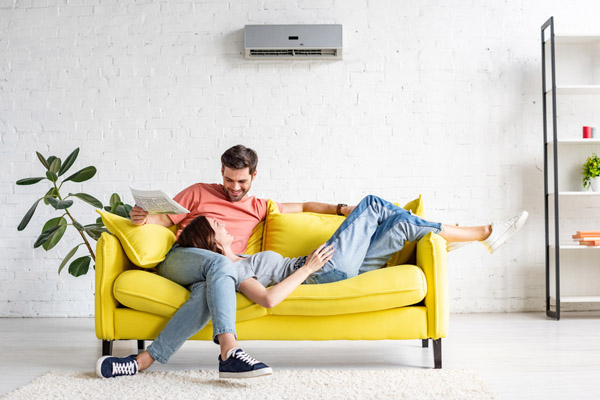How To Cool A Room Without AC

Many homes have a room or two that seem to feel much warmer than the rest of the home. The occupants of that room feel uncomfortable and need to find relief from the scorching heat. Also, many homes still exist that do not have a cooling system in place. For example, many historic or older homes fall under this category. Fortunately, there are ways to cool a room without AC, or a room without adequate air conditioning. The best-case scenario, however, is to discuss these types of issues with a licensed HVAC contractor. They will be able to offer practical solutions to remedy the problem.
How To Cool A Room Without AC
Contents
- 1 How To Cool A Room Without AC
- 1.1 1. Close And Cover Your Windows
- 1.2 2. Insulate And Shut Your Doors
- 1.3 3. Avoid Using The Oven
- 1.4 4. Change Your Light Bulbs
- 1.5 5. Use Fans Strategically
- 1.6 6. Manage Humidity
- 1.7 7. Allow In Night Air
- 1.8 8. Install Ductless Air Conditioning
- 1.9 9. Issues That Come With Window Air Conditioners
- 1.10 The Pros Of Ductless Cooling Systems
- 1.11 Conclusion
- 2 Call McAllister Energy To Learn More About Ductless HVAC Systems
In this article, we discuss nine ways to cool a room without AC.
1. Close And Cover Your Windows

About 76% of the sunlight that streams into your house through the windows plays a part in increasing the indoor temperature. Therefore, you should ideally keep your curtains closed or your blinds are drawn. According to the Department of Energy, you can use medium-colored drapes that come with white plastic backing to reduce the heat inside. Installing blackout curtains is also a great way of naturally insulating your rooms.
2. Insulate And Shut Your Doors
If you spend most of your time in one room, you should consider shutting the doors that lead to the other rooms in your house. By closing off those sections of the house, you can keep the cooler air in your house concentrated to a given area and you can help cool down the indoor space faster. If there are gaps in your doors, especially those that open to the outdoors, you should invest in insulation. Weatherstripping is a cost-effective option and you can install them on your own.
3. Avoid Using The Oven

Oven and burners emit heat, so be deliberate on the type of kitchen appliances you use. Outdoor grilling is a good alternative, or you can use summer recipes that don’t require heat.
4. Change Your Light Bulbs
Light bulbs too are a source of heat, albeit a less noticeable one. The biggest generators of heat are incandescent light bulbs which also waste 90% of the energy they consume. You can keep your home cooler by switching to LED lights or compact fluorescent lamps.
5. Use Fans Strategically

Fans don’t cool air, they just move it around. This means where you place your fan and what you do with it is what matters. Using your fans to create a cross breeze is the ideal way of circulating cool air and pushing hot air out. Therefore, you should find the coolest section of your house and then angle your fan toward the hotter section of your house. That way, you’ll pull cooler air from one end of your house and at the same time, eliminate hot air. You can also cool your house by placing a bowl of ice in front of your fan. With this trick, the cold air that’s emanating from the ice is blown into the room.
6. Manage Humidity
A dehumidifier won’t reduce the temperature, but it will help manage the thick, sticky air that makes hot conditions so intolerable. Humidity reduces how fast sweat evaporates and thus makes you feel sweatier and hotter.
7. Allow In Night Air
If you live in an area where the temperature drops at night, you can cool your room by opening your windows at night. But be sure to close them and blinds during the day.
8. Install Ductless Air Conditioning

If you have a problematic room(s) in your home, then you may want to consider a ductless cooling system. Ductless air conditioners have two main components: the outdoor unit and the indoor unit. Refrigerant tubing and electrical wiring connect the two parts. The compact indoor unit cools your indoor space and can be attached to any wall. Conversely, the outdoor unit releases the heat to the outdoors.
This kind of configuration comes with numerous benefits. Firstly, it offers you flexibility on where you can position your indoor unit. You’re not limited to an open window like window air conditioning systems. You can place it high on your wall so that it doesn’t affect your vertical storage units or interior décor.
Secondly, you can position it in any room. You don’t need a perimeter wall in the rooms because the outdoor and indoor components are already separate. Even your inner rooms can be served by this cooling solution. This is especially important for larger structures.
Thirdly, ductless air conditioning systems don’t block windows so you can enjoy natural lighting and views during the day. This is fantastic for small rooms with only one window. Besides, ductless AC units are typically quieter because the components that generate noise are placed outside the house.
9. Issues That Come With Window Air Conditioners
With window air conditioner units, all components come in one package. They push out hot air to the outdoors from one end and blow cold air into the indoors from the other end. The rooms need either a perimeter wall or existing windows for you to install a window air conditioning unit. Window air conditioners are typically simple and cheap, but they come with several downsides and limitations that make them less than ideal compared to ductless air conditioning systems,
- Blocks natural light when placed on a window
- Can only cool a single room at any given time
- Expensive to operate
- Noisy
- Prone to mold and bacterial growth, affecting indoor air quality
- Can be unsightly and can even attract thieves because they can easily be dislodged from their location on the window
The Pros Of Ductless Cooling Systems
- While the cost of installing ductless cooling systems is higher compared to that of window ACs, they are typically more energy-efficient and so will lower your cooling bills. The savings can be significant
- Quiet operation
- Unobtrusive design
- Ductless AC units are excellent for maintaining high indoor air quality because they come with multistage filters. With AC systems that don’t have an adequate filtering system, these air pollutants can stream into your indoor space and cause or exacerbate respiratory health issues.
Related Article: How Do Ductless Air Conditioners Work?
Conclusion
While you can use the strategies discussed in this article to keep your house cool without AC, most of them are less than ideal due to one reason or another. If you want to keep your room cool without compromising air quality, security, tranquility, ductless air conditioners are the best option.
Call McAllister Energy To Learn More About Ductless HVAC Systems

McAllister Energy provides the best cooling and heating services in the area. Our team consists of experienced certified technicians who can assist you with first-rate HVAC installations, repairs, tune-ups, and replacements. All of our technicians have years of experience and advanced knowledge to provide proper HVAC service.
McAllister Energy offers very competitive rates for cooling and heating services in the area. We can recommend the best HVAC replacement systems for you while staying within your budget. Our top priorities are comfort, indoor air quality, and energy efficiency, to name a few. Get in touch with McAllister Energy today for your free in-house estimate or to schedule an appointment.
You can click here to contact us now or call us at (856) 665-4545 to find out more!